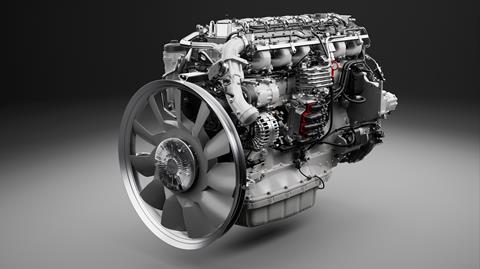Scania has introduced a new line of biogas engines that not only promise a 5% reduction in fuel consumption but also cater to the demands of long-haul operations.

These engines, initially previewed at last year’s IAA Transportation exhibitions, come equipped with a novel powertrain utilising two-thirds of the successful Super-based diesel powertrain.
The synergy between Scania’s 13-litre biogas engines, G25 gearboxes, and axles from the diesel counterpart has proven to be highly effective, resulting in the confirmed 5% fuel savings for long-haul journeys. Ola Henriksson, Senior Product Manager for Renewable Fuels at Scania Trucks, highlights the success of this combination, stating, “When paired with the Scania Opticruise gearbox and the new axles, the biogas engines can operate very close to their ‘sweet spot’ most of the time. Put together, it results in 5% fuel savings from this powertrain [compared to the previous].”
The application of bio-LNG or bio-CNG emerges as a practical strategy for achieving substantial co2 reductions immediately, without requiring any sacrifices. Scania’s biogas engines, boasting power options of 420hp or 460hp and ranges of up to 1,800km, present an attractive solution for even the most demanding long-haul operators.

As interest grows in locally produced biomethane fuels for trucks, such as bio-LNG or bio-CNG, companies are increasingly focused on decarbonising their road transports promptly. Biomethane-based solutions offer readily available alternatives through expanding fuel-station networks, with the potential to reduce CO2 emissions by up to 90% from a well-to-wheel perspective.
Henriksson emphasises the suitability of biomethane fuels for customers aiming to initiate decarbonisation immediately: “Our biogas engines cover a wide span of industries and applications. A 40-tonne tractor-and-trailer combination can achieve ranges of up to 1,800 km when specified with the biggest bio-LNG tank solutions that we offer,” he says.
Scania’s new biogas engines, based on the proven 13-litre gas engine, demonstrate the company’s dedication to gaining a larger market share in the pursuit of decarbonization. “With the CO2 reductions, the driveability, and the ranges we offer now, I am convinced that more customers will recognize what a great solution this is. There are so many obvious pros and virtually no cons at all. And the driver can also enjoy a significantly lower noise level.” . Henriksson concludes.
| OC13 103420 hp | OC13 104 460 hp | |
|---|---|---|
|
Type |
Inline |
Inline |
|
Displacement |
12.7 litres |
12.7 litres |
|
Firing order |
1-5-3-6-2-4 |
1-5-3-6-2-4 |
|
Cylinders |
6 |
6 |
|
Valves per cylinder |
4 |
4 |
|
Bore x stroke |
130 x 160 mm |
130 x 160 mm |
|
Compression |
12.6:1 |
12.6:1 |
|
Fuel injection |
Bosch + CEM1 |
Bosch + CEM1 |
|
Oil capacity |
43 litre |
43 litre |
|
Emission control |
Scania EGR and three-way catalytic converter |
Scania EGR and three-way catalytic converter |
|
Max. output |
420 (311 kW) @ 1900 /min |
460 (340 kW) @ 1900 r/min |
|
Max. torque |
2100 Nm @ 1000-1300 r/min |
2300 Nm @ 1000-1300 r/min |


















